Hospital Acquired Infections: Definition, Incidence, Consequences and Nursing Strategies
VerifiedAdded on 2023/06/18
|9
|2119
|497
AI Summary
This article discusses Hospital Acquired Infections, their definition, incidence, consequences and nursing strategies to avoid them. It also provides examples and references. Subject: Healthcare, Course Code: NA, Course Name: NA, College/University: NA
Contribute Materials
Your contribution can guide someone’s learning journey. Share your
documents today.
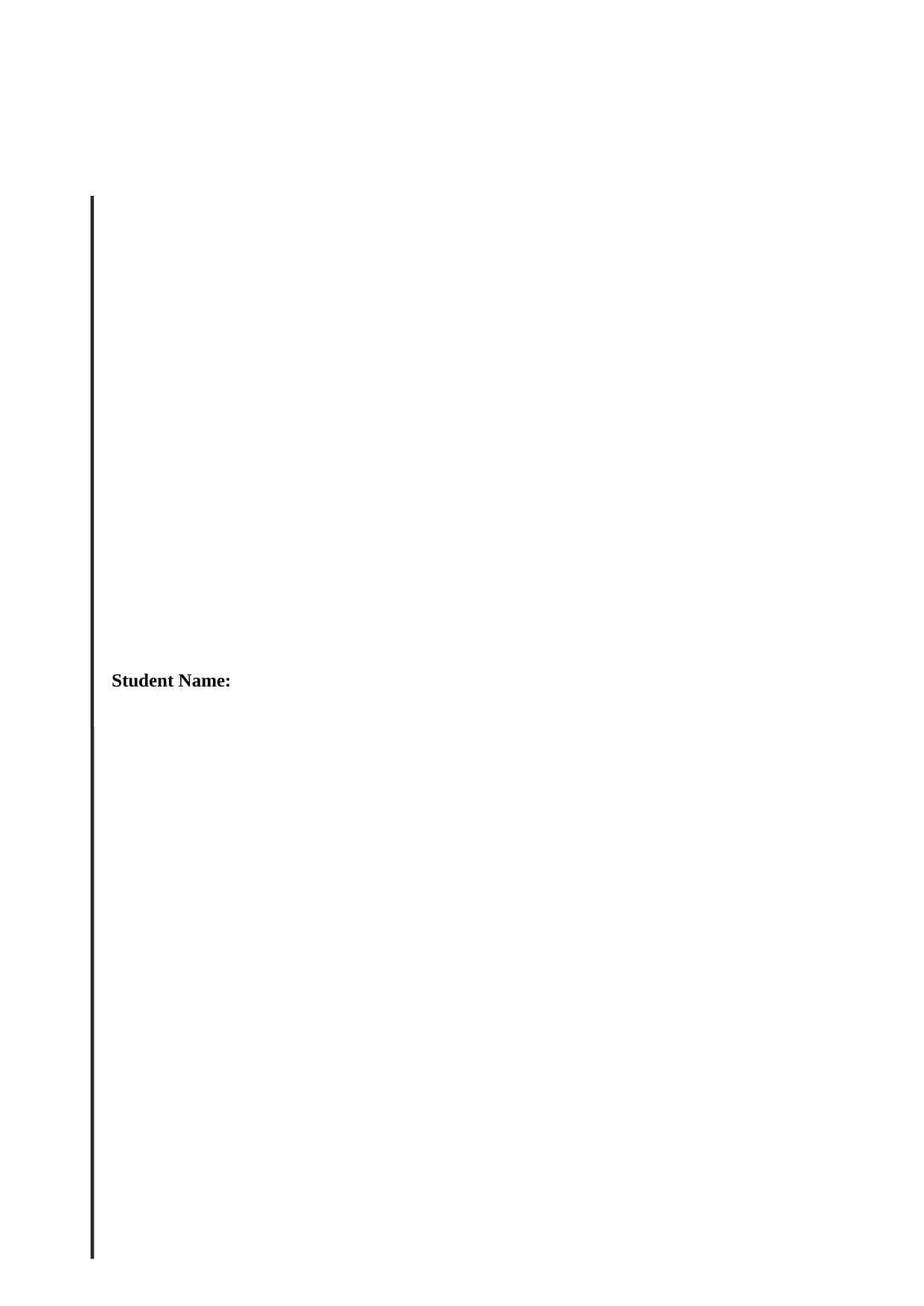
Student Name:
Secure Best Marks with AI Grader
Need help grading? Try our AI Grader for instant feedback on your assignments.
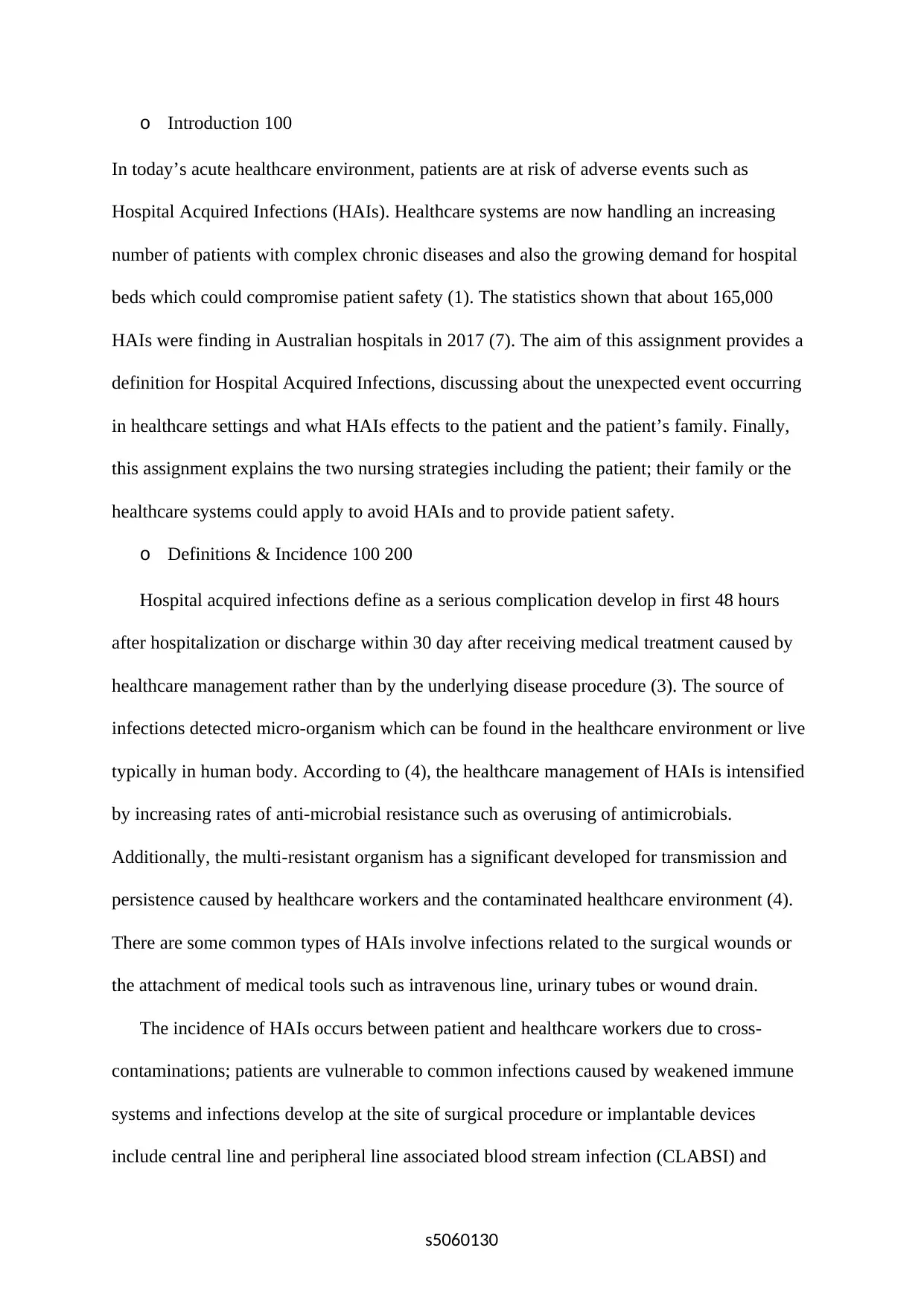
o Introduction 100
In today’s acute healthcare environment, patients are at risk of adverse events such as
Hospital Acquired Infections (HAIs). Healthcare systems are now handling an increasing
number of patients with complex chronic diseases and also the growing demand for hospital
beds which could compromise patient safety (1). The statistics shown that about 165,000
HAIs were finding in Australian hospitals in 2017 (7). The aim of this assignment provides a
definition for Hospital Acquired Infections, discussing about the unexpected event occurring
in healthcare settings and what HAIs effects to the patient and the patient’s family. Finally,
this assignment explains the two nursing strategies including the patient; their family or the
healthcare systems could apply to avoid HAIs and to provide patient safety.
o Definitions & Incidence 100 200
Hospital acquired infections define as a serious complication develop in first 48 hours
after hospitalization or discharge within 30 day after receiving medical treatment caused by
healthcare management rather than by the underlying disease procedure (3). The source of
infections detected micro-organism which can be found in the healthcare environment or live
typically in human body. According to (4), the healthcare management of HAIs is intensified
by increasing rates of anti-microbial resistance such as overusing of antimicrobials.
Additionally, the multi-resistant organism has a significant developed for transmission and
persistence caused by healthcare workers and the contaminated healthcare environment (4).
There are some common types of HAIs involve infections related to the surgical wounds or
the attachment of medical tools such as intravenous line, urinary tubes or wound drain.
The incidence of HAIs occurs between patient and healthcare workers due to cross-
contaminations; patients are vulnerable to common infections caused by weakened immune
systems and infections develop at the site of surgical procedure or implantable devices
include central line and peripheral line associated blood stream infection (CLABSI) and
s5060130
In today’s acute healthcare environment, patients are at risk of adverse events such as
Hospital Acquired Infections (HAIs). Healthcare systems are now handling an increasing
number of patients with complex chronic diseases and also the growing demand for hospital
beds which could compromise patient safety (1). The statistics shown that about 165,000
HAIs were finding in Australian hospitals in 2017 (7). The aim of this assignment provides a
definition for Hospital Acquired Infections, discussing about the unexpected event occurring
in healthcare settings and what HAIs effects to the patient and the patient’s family. Finally,
this assignment explains the two nursing strategies including the patient; their family or the
healthcare systems could apply to avoid HAIs and to provide patient safety.
o Definitions & Incidence 100 200
Hospital acquired infections define as a serious complication develop in first 48 hours
after hospitalization or discharge within 30 day after receiving medical treatment caused by
healthcare management rather than by the underlying disease procedure (3). The source of
infections detected micro-organism which can be found in the healthcare environment or live
typically in human body. According to (4), the healthcare management of HAIs is intensified
by increasing rates of anti-microbial resistance such as overusing of antimicrobials.
Additionally, the multi-resistant organism has a significant developed for transmission and
persistence caused by healthcare workers and the contaminated healthcare environment (4).
There are some common types of HAIs involve infections related to the surgical wounds or
the attachment of medical tools such as intravenous line, urinary tubes or wound drain.
The incidence of HAIs occurs between patient and healthcare workers due to cross-
contaminations; patients are vulnerable to common infections caused by weakened immune
systems and infections develop at the site of surgical procedure or implantable devices
include central line and peripheral line associated blood stream infection (CLABSI) and
s5060130
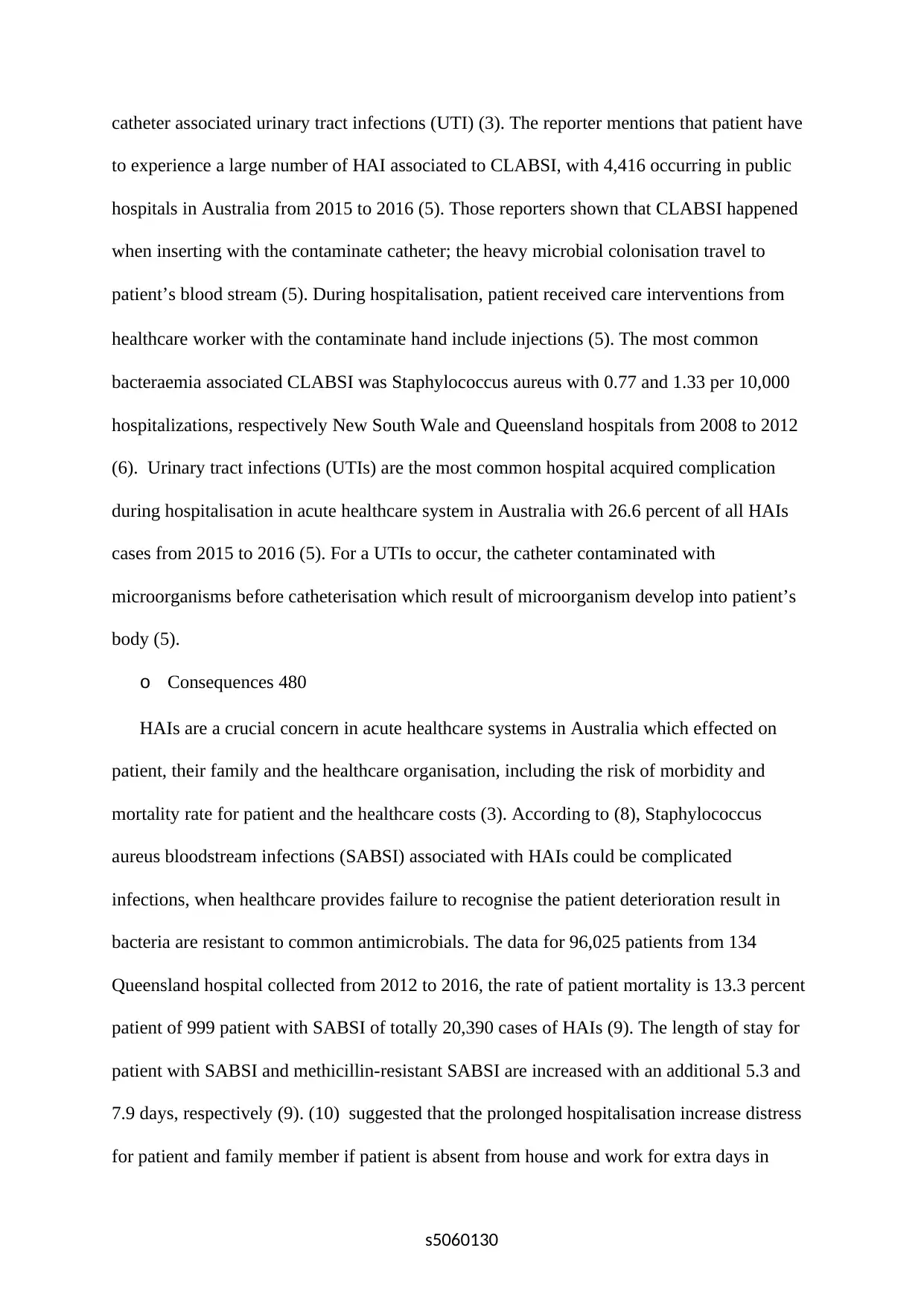
catheter associated urinary tract infections (UTI) (3). The reporter mentions that patient have
to experience a large number of HAI associated to CLABSI, with 4,416 occurring in public
hospitals in Australia from 2015 to 2016 (5). Those reporters shown that CLABSI happened
when inserting with the contaminate catheter; the heavy microbial colonisation travel to
patient’s blood stream (5). During hospitalisation, patient received care interventions from
healthcare worker with the contaminate hand include injections (5). The most common
bacteraemia associated CLABSI was Staphylococcus aureus with 0.77 and 1.33 per 10,000
hospitalizations, respectively New South Wale and Queensland hospitals from 2008 to 2012
(6). Urinary tract infections (UTIs) are the most common hospital acquired complication
during hospitalisation in acute healthcare system in Australia with 26.6 percent of all HAIs
cases from 2015 to 2016 (5). For a UTIs to occur, the catheter contaminated with
microorganisms before catheterisation which result of microorganism develop into patient’s
body (5).
o Consequences 480
HAIs are a crucial concern in acute healthcare systems in Australia which effected on
patient, their family and the healthcare organisation, including the risk of morbidity and
mortality rate for patient and the healthcare costs (3). According to (8), Staphylococcus
aureus bloodstream infections (SABSI) associated with HAIs could be complicated
infections, when healthcare provides failure to recognise the patient deterioration result in
bacteria are resistant to common antimicrobials. The data for 96,025 patients from 134
Queensland hospital collected from 2012 to 2016, the rate of patient mortality is 13.3 percent
patient of 999 patient with SABSI of totally 20,390 cases of HAIs (9). The length of stay for
patient with SABSI and methicillin-resistant SABSI are increased with an additional 5.3 and
7.9 days, respectively (9). (10) suggested that the prolonged hospitalisation increase distress
for patient and family member if patient is absent from house and work for extra days in
s5060130
to experience a large number of HAI associated to CLABSI, with 4,416 occurring in public
hospitals in Australia from 2015 to 2016 (5). Those reporters shown that CLABSI happened
when inserting with the contaminate catheter; the heavy microbial colonisation travel to
patient’s blood stream (5). During hospitalisation, patient received care interventions from
healthcare worker with the contaminate hand include injections (5). The most common
bacteraemia associated CLABSI was Staphylococcus aureus with 0.77 and 1.33 per 10,000
hospitalizations, respectively New South Wale and Queensland hospitals from 2008 to 2012
(6). Urinary tract infections (UTIs) are the most common hospital acquired complication
during hospitalisation in acute healthcare system in Australia with 26.6 percent of all HAIs
cases from 2015 to 2016 (5). For a UTIs to occur, the catheter contaminated with
microorganisms before catheterisation which result of microorganism develop into patient’s
body (5).
o Consequences 480
HAIs are a crucial concern in acute healthcare systems in Australia which effected on
patient, their family and the healthcare organisation, including the risk of morbidity and
mortality rate for patient and the healthcare costs (3). According to (8), Staphylococcus
aureus bloodstream infections (SABSI) associated with HAIs could be complicated
infections, when healthcare provides failure to recognise the patient deterioration result in
bacteria are resistant to common antimicrobials. The data for 96,025 patients from 134
Queensland hospital collected from 2012 to 2016, the rate of patient mortality is 13.3 percent
patient of 999 patient with SABSI of totally 20,390 cases of HAIs (9). The length of stay for
patient with SABSI and methicillin-resistant SABSI are increased with an additional 5.3 and
7.9 days, respectively (9). (10) suggested that the prolonged hospitalisation increase distress
for patient and family member if patient is absent from house and work for extra days in
s5060130
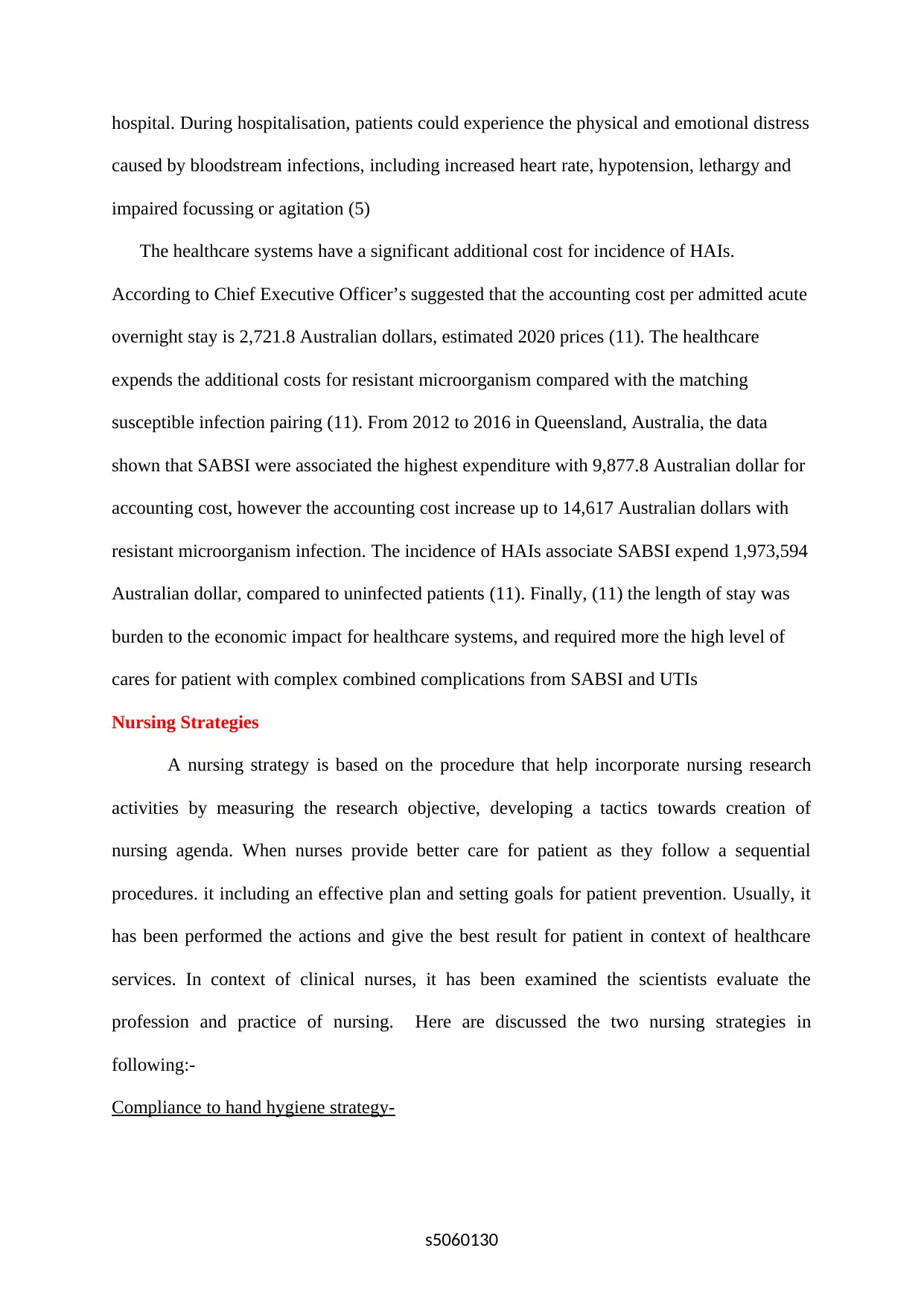
hospital. During hospitalisation, patients could experience the physical and emotional distress
caused by bloodstream infections, including increased heart rate, hypotension, lethargy and
impaired focussing or agitation (5)
The healthcare systems have a significant additional cost for incidence of HAIs.
According to Chief Executive Officer’s suggested that the accounting cost per admitted acute
overnight stay is 2,721.8 Australian dollars, estimated 2020 prices (11). The healthcare
expends the additional costs for resistant microorganism compared with the matching
susceptible infection pairing (11). From 2012 to 2016 in Queensland, Australia, the data
shown that SABSI were associated the highest expenditure with 9,877.8 Australian dollar for
accounting cost, however the accounting cost increase up to 14,617 Australian dollars with
resistant microorganism infection. The incidence of HAIs associate SABSI expend 1,973,594
Australian dollar, compared to uninfected patients (11). Finally, (11) the length of stay was
burden to the economic impact for healthcare systems, and required more the high level of
cares for patient with complex combined complications from SABSI and UTIs
Nursing Strategies
A nursing strategy is based on the procedure that help incorporate nursing research
activities by measuring the research objective, developing a tactics towards creation of
nursing agenda. When nurses provide better care for patient as they follow a sequential
procedures. it including an effective plan and setting goals for patient prevention. Usually, it
has been performed the actions and give the best result for patient in context of healthcare
services. In context of clinical nurses, it has been examined the scientists evaluate the
profession and practice of nursing. Here are discussed the two nursing strategies in
following:-
Compliance to hand hygiene strategy-
s5060130
caused by bloodstream infections, including increased heart rate, hypotension, lethargy and
impaired focussing or agitation (5)
The healthcare systems have a significant additional cost for incidence of HAIs.
According to Chief Executive Officer’s suggested that the accounting cost per admitted acute
overnight stay is 2,721.8 Australian dollars, estimated 2020 prices (11). The healthcare
expends the additional costs for resistant microorganism compared with the matching
susceptible infection pairing (11). From 2012 to 2016 in Queensland, Australia, the data
shown that SABSI were associated the highest expenditure with 9,877.8 Australian dollar for
accounting cost, however the accounting cost increase up to 14,617 Australian dollars with
resistant microorganism infection. The incidence of HAIs associate SABSI expend 1,973,594
Australian dollar, compared to uninfected patients (11). Finally, (11) the length of stay was
burden to the economic impact for healthcare systems, and required more the high level of
cares for patient with complex combined complications from SABSI and UTIs
Nursing Strategies
A nursing strategy is based on the procedure that help incorporate nursing research
activities by measuring the research objective, developing a tactics towards creation of
nursing agenda. When nurses provide better care for patient as they follow a sequential
procedures. it including an effective plan and setting goals for patient prevention. Usually, it
has been performed the actions and give the best result for patient in context of healthcare
services. In context of clinical nurses, it has been examined the scientists evaluate the
profession and practice of nursing. Here are discussed the two nursing strategies in
following:-
Compliance to hand hygiene strategy-
s5060130
Secure Best Marks with AI Grader
Need help grading? Try our AI Grader for instant feedback on your assignments.
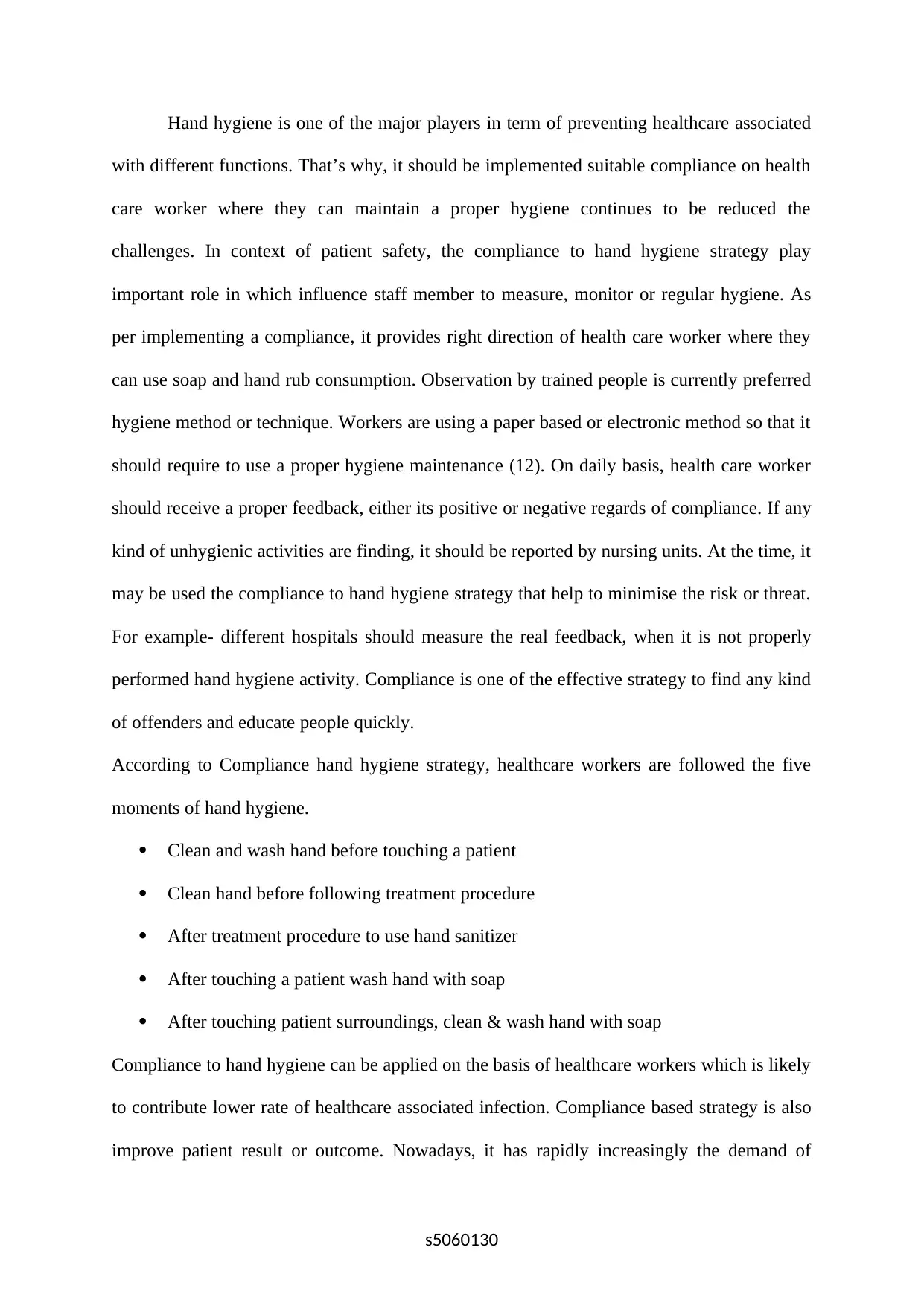
Hand hygiene is one of the major players in term of preventing healthcare associated
with different functions. That’s why, it should be implemented suitable compliance on health
care worker where they can maintain a proper hygiene continues to be reduced the
challenges. In context of patient safety, the compliance to hand hygiene strategy play
important role in which influence staff member to measure, monitor or regular hygiene. As
per implementing a compliance, it provides right direction of health care worker where they
can use soap and hand rub consumption. Observation by trained people is currently preferred
hygiene method or technique. Workers are using a paper based or electronic method so that it
should require to use a proper hygiene maintenance (12). On daily basis, health care worker
should receive a proper feedback, either its positive or negative regards of compliance. If any
kind of unhygienic activities are finding, it should be reported by nursing units. At the time, it
may be used the compliance to hand hygiene strategy that help to minimise the risk or threat.
For example- different hospitals should measure the real feedback, when it is not properly
performed hand hygiene activity. Compliance is one of the effective strategy to find any kind
of offenders and educate people quickly.
According to Compliance hand hygiene strategy, healthcare workers are followed the five
moments of hand hygiene.
Clean and wash hand before touching a patient
Clean hand before following treatment procedure
After treatment procedure to use hand sanitizer
After touching a patient wash hand with soap
After touching patient surroundings, clean & wash hand with soap
Compliance to hand hygiene can be applied on the basis of healthcare workers which is likely
to contribute lower rate of healthcare associated infection. Compliance based strategy is also
improve patient result or outcome. Nowadays, it has rapidly increasingly the demand of
s5060130
with different functions. That’s why, it should be implemented suitable compliance on health
care worker where they can maintain a proper hygiene continues to be reduced the
challenges. In context of patient safety, the compliance to hand hygiene strategy play
important role in which influence staff member to measure, monitor or regular hygiene. As
per implementing a compliance, it provides right direction of health care worker where they
can use soap and hand rub consumption. Observation by trained people is currently preferred
hygiene method or technique. Workers are using a paper based or electronic method so that it
should require to use a proper hygiene maintenance (12). On daily basis, health care worker
should receive a proper feedback, either its positive or negative regards of compliance. If any
kind of unhygienic activities are finding, it should be reported by nursing units. At the time, it
may be used the compliance to hand hygiene strategy that help to minimise the risk or threat.
For example- different hospitals should measure the real feedback, when it is not properly
performed hand hygiene activity. Compliance is one of the effective strategy to find any kind
of offenders and educate people quickly.
According to Compliance hand hygiene strategy, healthcare workers are followed the five
moments of hand hygiene.
Clean and wash hand before touching a patient
Clean hand before following treatment procedure
After treatment procedure to use hand sanitizer
After touching a patient wash hand with soap
After touching patient surroundings, clean & wash hand with soap
Compliance to hand hygiene can be applied on the basis of healthcare workers which is likely
to contribute lower rate of healthcare associated infection. Compliance based strategy is also
improve patient result or outcome. Nowadays, it has rapidly increasingly the demand of
s5060130
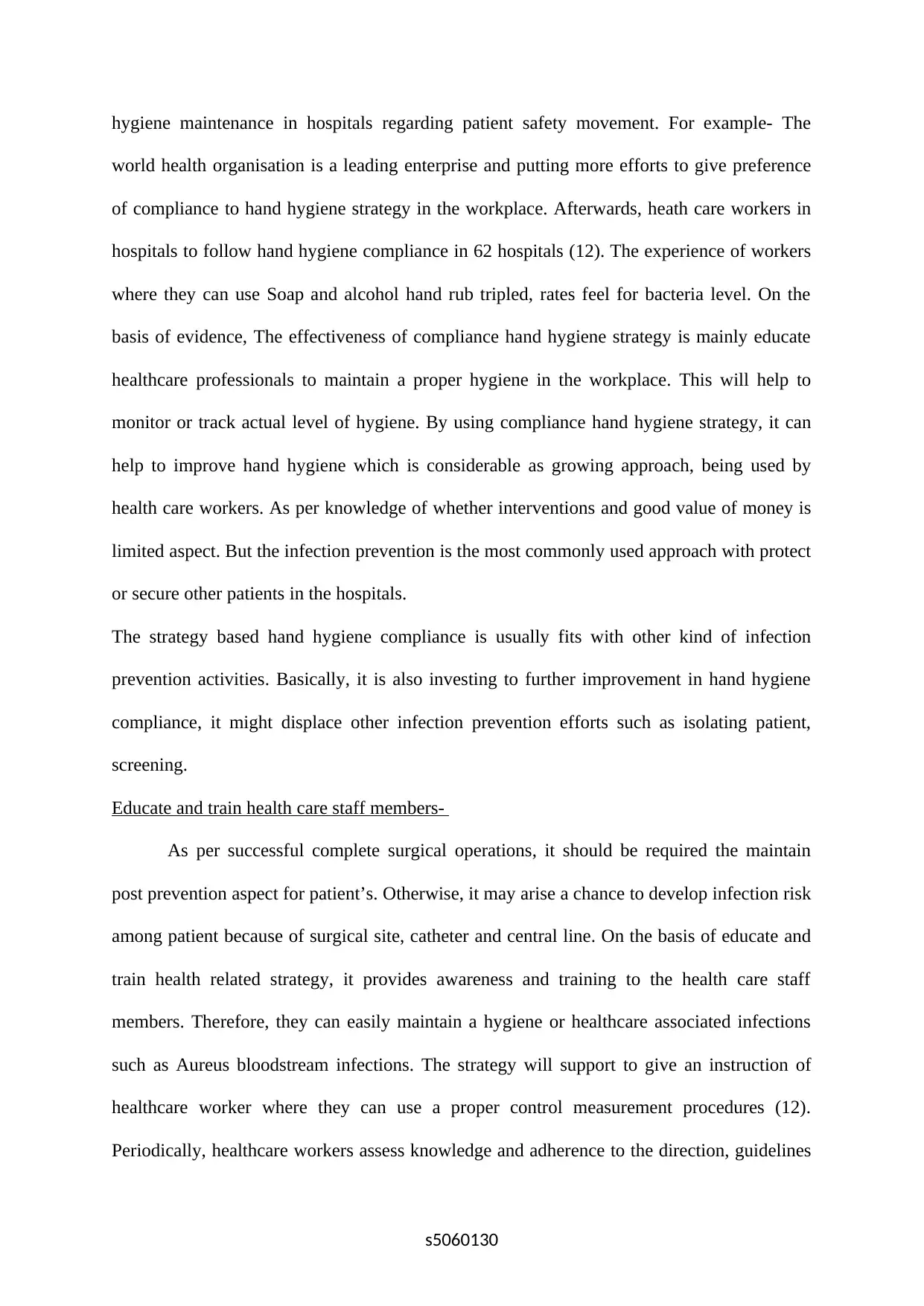
hygiene maintenance in hospitals regarding patient safety movement. For example- The
world health organisation is a leading enterprise and putting more efforts to give preference
of compliance to hand hygiene strategy in the workplace. Afterwards, heath care workers in
hospitals to follow hand hygiene compliance in 62 hospitals (12). The experience of workers
where they can use Soap and alcohol hand rub tripled, rates feel for bacteria level. On the
basis of evidence, The effectiveness of compliance hand hygiene strategy is mainly educate
healthcare professionals to maintain a proper hygiene in the workplace. This will help to
monitor or track actual level of hygiene. By using compliance hand hygiene strategy, it can
help to improve hand hygiene which is considerable as growing approach, being used by
health care workers. As per knowledge of whether interventions and good value of money is
limited aspect. But the infection prevention is the most commonly used approach with protect
or secure other patients in the hospitals.
The strategy based hand hygiene compliance is usually fits with other kind of infection
prevention activities. Basically, it is also investing to further improvement in hand hygiene
compliance, it might displace other infection prevention efforts such as isolating patient,
screening.
Educate and train health care staff members-
As per successful complete surgical operations, it should be required the maintain
post prevention aspect for patient’s. Otherwise, it may arise a chance to develop infection risk
among patient because of surgical site, catheter and central line. On the basis of educate and
train health related strategy, it provides awareness and training to the health care staff
members. Therefore, they can easily maintain a hygiene or healthcare associated infections
such as Aureus bloodstream infections. The strategy will support to give an instruction of
healthcare worker where they can use a proper control measurement procedures (12).
Periodically, healthcare workers assess knowledge and adherence to the direction, guidelines
s5060130
world health organisation is a leading enterprise and putting more efforts to give preference
of compliance to hand hygiene strategy in the workplace. Afterwards, heath care workers in
hospitals to follow hand hygiene compliance in 62 hospitals (12). The experience of workers
where they can use Soap and alcohol hand rub tripled, rates feel for bacteria level. On the
basis of evidence, The effectiveness of compliance hand hygiene strategy is mainly educate
healthcare professionals to maintain a proper hygiene in the workplace. This will help to
monitor or track actual level of hygiene. By using compliance hand hygiene strategy, it can
help to improve hand hygiene which is considerable as growing approach, being used by
health care workers. As per knowledge of whether interventions and good value of money is
limited aspect. But the infection prevention is the most commonly used approach with protect
or secure other patients in the hospitals.
The strategy based hand hygiene compliance is usually fits with other kind of infection
prevention activities. Basically, it is also investing to further improvement in hand hygiene
compliance, it might displace other infection prevention efforts such as isolating patient,
screening.
Educate and train health care staff members-
As per successful complete surgical operations, it should be required the maintain
post prevention aspect for patient’s. Otherwise, it may arise a chance to develop infection risk
among patient because of surgical site, catheter and central line. On the basis of educate and
train health related strategy, it provides awareness and training to the health care staff
members. Therefore, they can easily maintain a hygiene or healthcare associated infections
such as Aureus bloodstream infections. The strategy will support to give an instruction of
healthcare worker where they can use a proper control measurement procedures (12).
Periodically, healthcare workers assess knowledge and adherence to the direction, guidelines
s5060130

for all personnel involved in context of insertion and maintenance of intravascular catheters.
At that time, nursing staff member should use strategy while identifying the level of patient in
ICU.
Sometimes, it has suggested that use of suitable strategy associated with managing
and controlling the prevention aspect of patient after post-surgical procedure. This is not only
helping to give an excellent quality of prevention facilities of patient after surgical operation.
But it is also developing a more awareness among health care professionals. Therefore, it
ensuring all necessary prevention aspect at the time complex situation or condition.
For example- by using Educate and train strategy, health care worker will try to avoid
risk or threat, and benefits of replacing a central device at a recommended site to minimise
the infection related complication against risk for mechanical complication. This kind of
situation will be managed by healthcare workers.
Another example is related to the catherters and surgical sites, health care worker
needs to use upper-extremity site for purpose of catheter insertion. Because it help to replace
catheter easily in lower site as soon as possible. Workers are trying to avoid use of steel
needless and it might have cause tissues necrosis if any kind of extravasation happens.
On the basis of examples, it has been examined the importance of educate and train
health workers, who will be managing and controlling risk or threat in hospitals. That’s why,
it is an essential aspect to educate health care workers where they can gain more knowledge
and used in right manner. Moreover, healthcare worker have already trained and educate
about the complication and infectious risks after surgical procedure. That’s why, nursing staff
members should be used this trained strategy to improve their own ability or capability. In
future, it will support for health care workers to make an important decision immediately.
s5060130
At that time, nursing staff member should use strategy while identifying the level of patient in
ICU.
Sometimes, it has suggested that use of suitable strategy associated with managing
and controlling the prevention aspect of patient after post-surgical procedure. This is not only
helping to give an excellent quality of prevention facilities of patient after surgical operation.
But it is also developing a more awareness among health care professionals. Therefore, it
ensuring all necessary prevention aspect at the time complex situation or condition.
For example- by using Educate and train strategy, health care worker will try to avoid
risk or threat, and benefits of replacing a central device at a recommended site to minimise
the infection related complication against risk for mechanical complication. This kind of
situation will be managed by healthcare workers.
Another example is related to the catherters and surgical sites, health care worker
needs to use upper-extremity site for purpose of catheter insertion. Because it help to replace
catheter easily in lower site as soon as possible. Workers are trying to avoid use of steel
needless and it might have cause tissues necrosis if any kind of extravasation happens.
On the basis of examples, it has been examined the importance of educate and train
health workers, who will be managing and controlling risk or threat in hospitals. That’s why,
it is an essential aspect to educate health care workers where they can gain more knowledge
and used in right manner. Moreover, healthcare worker have already trained and educate
about the complication and infectious risks after surgical procedure. That’s why, nursing staff
members should be used this trained strategy to improve their own ability or capability. In
future, it will support for health care workers to make an important decision immediately.
s5060130
Paraphrase This Document
Need a fresh take? Get an instant paraphrase of this document with our AI Paraphraser

Conclusion 100
s5060130
s5060130
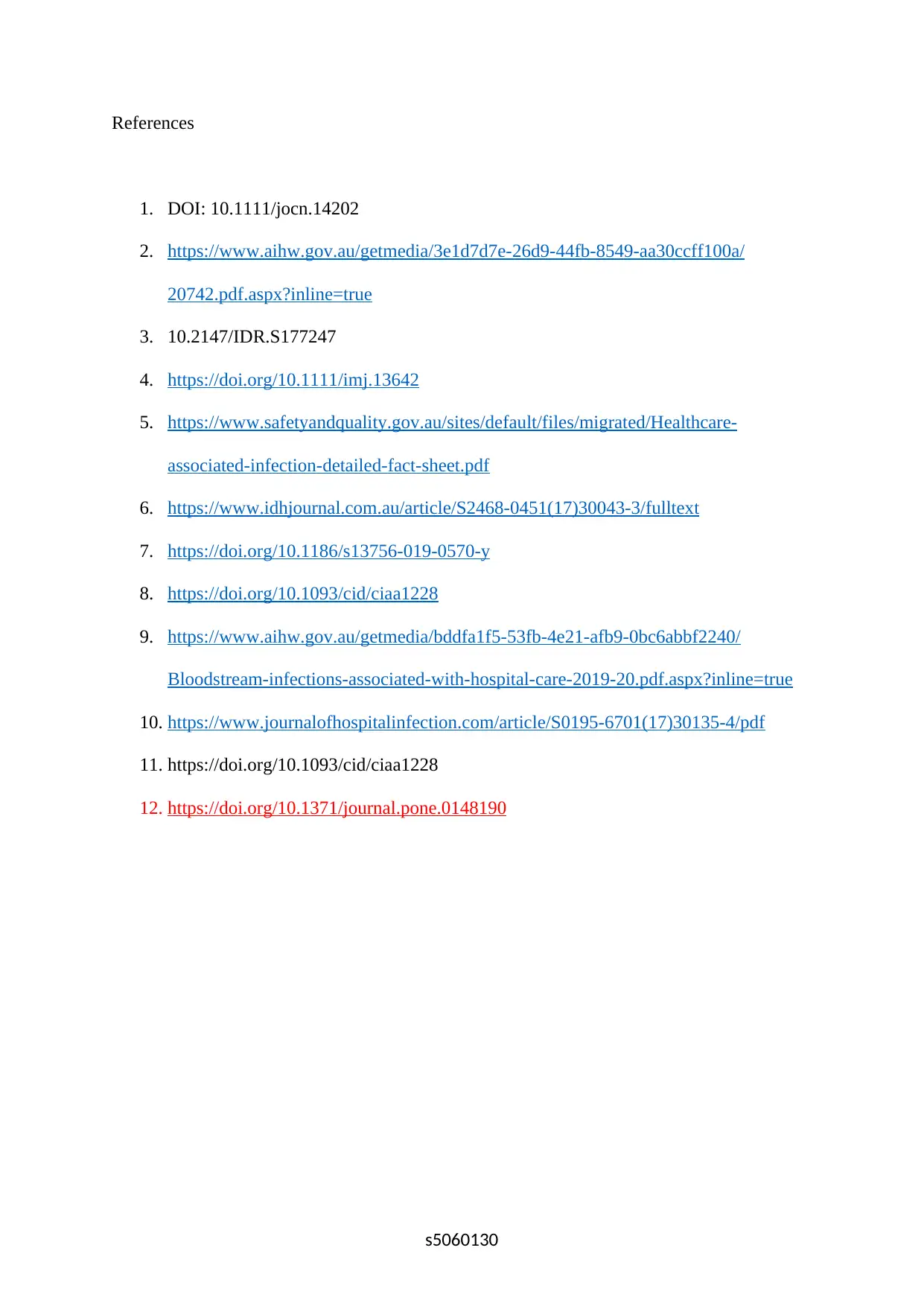
References
1. DOI: 10.1111/jocn.14202
2. https://www.aihw.gov.au/getmedia/3e1d7d7e-26d9-44fb-8549-aa30ccff100a/
20742.pdf.aspx?inline=true
3. 10.2147/IDR.S177247
4. https://doi.org/10.1111/imj.13642
5. https://www.safetyandquality.gov.au/sites/default/files/migrated/Healthcare-
associated-infection-detailed-fact-sheet.pdf
6. https://www.idhjournal.com.au/article/S2468-0451(17)30043-3/fulltext
7. https://doi.org/10.1186/s13756-019-0570-y
8. https://doi.org/10.1093/cid/ciaa1228
9. https://www.aihw.gov.au/getmedia/bddfa1f5-53fb-4e21-afb9-0bc6abbf2240/
Bloodstream-infections-associated-with-hospital-care-2019-20.pdf.aspx?inline=true
10. https://www.journalofhospitalinfection.com/article/S0195-6701(17)30135-4/pdf
11. https://doi.org/10.1093/cid/ciaa1228
12. https://doi.org/10.1371/journal.pone.0148190
s5060130
1. DOI: 10.1111/jocn.14202
2. https://www.aihw.gov.au/getmedia/3e1d7d7e-26d9-44fb-8549-aa30ccff100a/
20742.pdf.aspx?inline=true
3. 10.2147/IDR.S177247
4. https://doi.org/10.1111/imj.13642
5. https://www.safetyandquality.gov.au/sites/default/files/migrated/Healthcare-
associated-infection-detailed-fact-sheet.pdf
6. https://www.idhjournal.com.au/article/S2468-0451(17)30043-3/fulltext
7. https://doi.org/10.1186/s13756-019-0570-y
8. https://doi.org/10.1093/cid/ciaa1228
9. https://www.aihw.gov.au/getmedia/bddfa1f5-53fb-4e21-afb9-0bc6abbf2240/
Bloodstream-infections-associated-with-hospital-care-2019-20.pdf.aspx?inline=true
10. https://www.journalofhospitalinfection.com/article/S0195-6701(17)30135-4/pdf
11. https://doi.org/10.1093/cid/ciaa1228
12. https://doi.org/10.1371/journal.pone.0148190
s5060130
1 out of 9
Related Documents
Your All-in-One AI-Powered Toolkit for Academic Success.
+13062052269
info@desklib.com
Available 24*7 on WhatsApp / Email
![[object Object]](/_next/static/media/star-bottom.7253800d.svg)
Unlock your academic potential
© 2024 | Zucol Services PVT LTD | All rights reserved.





